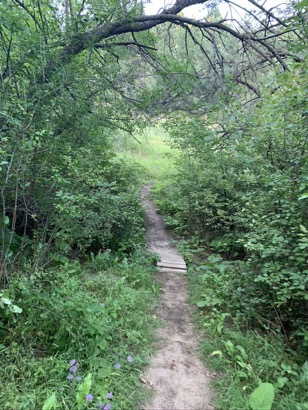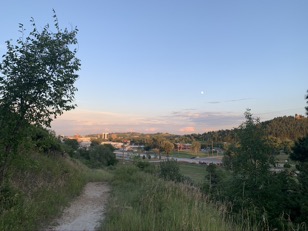The city meets wild lands
01/08/20 02:25

Shortly before we left Idaho for South Dakota, we had a conversation with our friend Chris about our plans. Chris worked for the USDA Forest Service. Most of the time he worked on mapping and planning for the management of National Forests, based in Boise, Idaho. But, as was true of many of his colleagues, he could be summoned and reassigned at a moment’s notice by the Interagency Fire Center, which was also located in Boise. The Interagency Fire Center deploys personnel and material resources to large wildfires wherever they happen in the United States. Chris had to be trained not only for making maps and preparing planning documents for forest management, he also had to be trained for deploying and managing resources for fighting large fires in a wide variety of different terrains, settings and situations. Our conversation with Chris included his telling of a recent training that he had participated in that focused on the urban wild lands interface. Fighting a fire in a forest requires a particular set of skills, training and equipment. Fighting a fire in an urban neighborhood requires a different set of skills, training and equipment. I paid attention to what Chris was saying because we had just purchased a home that was on the edge of the forest, not far from National Forest land. Chris was familiar with the name of our subdivision, Countryside and told us that the neighborhood was featured in one of the training films that he had just watched.
Over the years since that time, we have grown to deeply appreciate the interface of urban areas and wild lands that is Rapid City. Rapid City is located right where the Black Hills meet the prairie. As the city continued to grow after a devastating flood in 1972, more and more private homes were built into the hills on the western side of the city. Leaving a flood control green space alongside the creek, the city stretched itself out into the hills and also onto the prairie to the East. Our home is in a neighborhood that for most of the time we’ve lived here was outside of the city limits. Since we have been annexed, the cul-de-sac at the end of our street is the farthest the city stretches in that direction. Beyond that, private land continues for a short distance, but it is not highly developed and soon the National Forest begins. We have known that there is a risk of wildfire sweeping across the forest and into our neighborhood and have tried to be responsible in the maintenance of our property to prevent wildfire from starting here and to make it easy for firefighters to defend the structure were a fire to come.

It is not just private homeowners who have access to wild lands, however. Rapid City has many points for very easy public access to the wild places within the city.
The Sturgis Motorcycle Rally is just a week away and although we know that the numbers of guests will be lower than many other years due to the pandemic, we are bracing for an influx of people who will travel to the hills to share some of the beauty of the place where we live. They will be spreading out, spending less time at concerts and the shops of vendors and more time out riding in the hills with plenty of physical distance. Preparing for the influx of guests comes naturally to those of us who have lived here for a while. Friends and family members who live in other places love to come to the hills and most of the time we are glad to see them. We take them to Badlands National Park and Mount Rushmore National Monument. We show them Crazy Horse and drive the wildlife loop in Custer State Park. We tell them about Bear Country and Reptile Gardens and the 1880’s Train. We let them know about boating on Pactola or Sheridan Lake. We tell them about hiking the Mickelson and Centennial Trails.
We don’t, however, tell them about some of the secret places right in our city. Since we have been observing the discipline of a 2 - 5 mile walk every day, we have discovered more of the urban wild lands interface that Rapid City has to offer. Last night we drove from the edge of the city to near its downtown center, parked our car and walked right into wild land. We had the trail mostly to ourselves and soon we were on a side path that wound through the forest with no other users. We had the hillside and the exquisite views to ourselves for a little while. The place where we were walking is all public access. Our car was parked in a free public parking lot. The pictures that appear with this journal entry were all taken within the city limits within a half mile of a major city street. The shape of the hills and the presence of the trees isolated us from the street noise as we walked. The peace of the evening was just what we needed after a busy day of sorting and packing and feeling like we are in the midst of a job that is bigger than we are.

